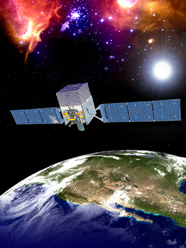What is Fermi?
 The Universe is home to numerous exotic and beautiful phenomena, some of which can generate almost inconceivable amounts of energy. Supermassive black holes, merging neutron stars, streams of hot gas moving close to the speed of light ... these are but a few of the marvels that generate gamma-ray radiation, the most energetic form of radiation, billions of times more energetic than the type of light visible to our eyes. What is happening to produce this much energy? What happens to the surrounding environment near these phenomena? How will studying these energetic objects add to our understanding of the very nature of the Universe and how it behaves?
The Universe is home to numerous exotic and beautiful phenomena, some of which can generate almost inconceivable amounts of energy. Supermassive black holes, merging neutron stars, streams of hot gas moving close to the speed of light ... these are but a few of the marvels that generate gamma-ray radiation, the most energetic form of radiation, billions of times more energetic than the type of light visible to our eyes. What is happening to produce this much energy? What happens to the surrounding environment near these phenomena? How will studying these energetic objects add to our understanding of the very nature of the Universe and how it behaves?
The Fermi Gamma-ray Space Telescope, formerly GLAST, is opening this high-energy world to exploration and helping us answer these questions. With Fermi, astronomers at long last have a superior tool to study how black holes, notorious for pulling matter in, can accelerate jets of gas outward at fantastic speeds. Physicists are able to study subatomic particles at energies far greater than those seen in ground-based particle accelerators. And cosmologists are gaining valuable information about the birth and early evolution of the Universe.
For this unique endeavor, one that brings together the astrophysics and particle physics communities, NASA has teamed up with the U.S. Department of Energy and institutions in France, Germany, Japan, Italy and Sweden. General Dynamics was chosen to build the spacecraft. Fermi was launched June 11, 2008 at 12:05 pm EDT.
Latest News
Jul 25, 2024
NASA's Fermi Finds New Feature in Brightest Gamma-Ray Burst Yet Seen Summary
In October 2022, astronomers were stunned by what was quickly dubbed the BOAT - the brightest-of-all-time gamma-ray burst (GRB). Now an international science team reports that data from NASA's Fermi Gamma-ray Space Telescope reveals a feature never seen before.
+ Read More
Jun 6, 2024
Announcement of the Gamma-ray Data Tools (GDT)
The Gamma-ray Data Tools (GDT) is an open-source Python-based centralized toolkit for analyzing data from space-based hard X-ray and gamma-ray instruments. The GDT borrows its heritage from, and supersedes, the Fermi GBM Data Tools. The GDT is designed with a "core" package that contains generalized functionality and base classes that are utilized by a variety of mission packages. For more information see the GBM Software Page.
Jun 5, 2024
Fermi Cycle-17 GI Program Selections Announced
The stage-I selection process for the Fermi Cycle-17 Guest Investigator program has been completed. There were a total of 37 new programs selected out of 113 proposals submitted. A list of the selected programs, including the PIs, titles and abstracts is available on the FSSC web site.



